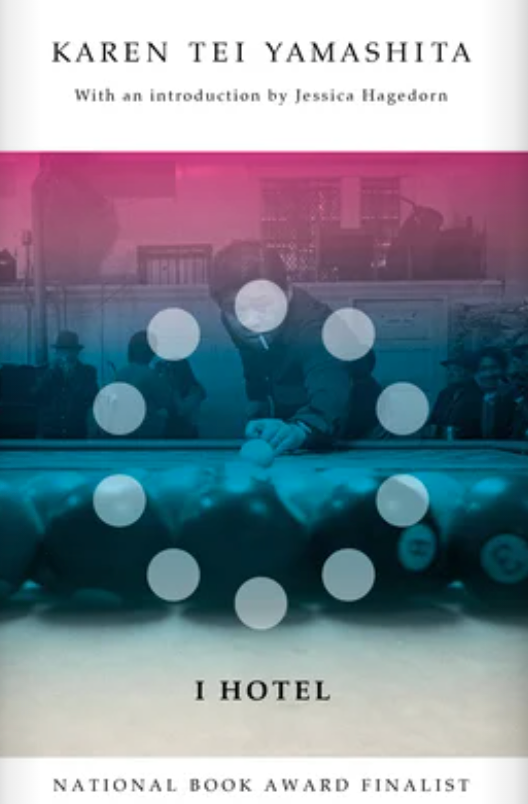Why Everyone Should Read the Great Karen Tei Yamashita
Josh Cook on This Year’s Recipient of the National Book Foundations’s Literarian Award
Winners of the National Book Foundation’s Medal for Distinguished Contributions to American Letters tend to be household names in the world of books by the time they win. Walter Mosley had published over sixty books and won a Mystery Writers of America Grandmaster Award and a PEN America Lifetime Achievement Award. Edmund White had won the Saul Bellow Award for Achievement in American Fiction, a Stonewall Book Award, and a National Book Critics Circle Award. Isabelle Allende’s books had sold 70 million copies. Annie Proulx had won a National Book Award and a Pulitzer Prize and an Oscar-winning movie had been made from her short story “Brokeback Mountain.” The list of past winners continues through bestsellers, prize winners, and standard bearers.
There can be many reasons and no reason why a brilliant author hasn’t reached certain levels of acclaim. Karen Tei Yamashita does not center her books on white narratives and does not set her books on the East coast. She is published by Coffee House Press, a small independent publisher in Minneapolis, rather than a massive publisher in New York. She has not won a fame-inducing prize like a Pulitzer, Booker, or National Book Award. She also hasn’t picked a literary lane, not just in terms of form—writing novels, short stories, nonfiction, and plays—but in terms of style and themes as well, writing historical fiction, magical realism, postmodern maximalism, social realism, and more.
Though the diversity of her oeuvre makes it easy to sell specific books to specific readers, it makes it difficult to sell her as the great American writer she is. It is difficult to say exactly what makes a Yamashita book a Yamashita book. The result is a body of work that doesn’t quite cohere, at least not in the way contemporary publicity would prefer.
I’d argue that diversity of project is what makes Yamashita such an important writer and why she is uniquely deserving of this award. Through her works, Yamashita paints a picture of America in perhaps the only way it can be accurately portrayed; not as a monolith, not as a manifested destiny, and not as a melting pot, but as a mosaic whose tiles don’t quite line up. A mosaic with gaps, contradictions, and clashes, that doesn’t completely cohere into a single image. Through her body of work Yamashita goes beyond questioning the myths of America to arguing there is no singular America to have myths at all.
If you are new to Yamashita, this means her voice is so varied and playful and her topics so diverse that any book is an appropriate introduction. Here, though, are five of her books to help you find a place to start.
*

Sansei & Sensibility collects a number of short stories from Yamashita’s career that look forward to some of the themes and narrative techniques she fleshes out in novels, giving readers a bite-sized introduction to her work. The other pieces are retellings of Jane Austen novels. Though presented as a writing exercise to connect with her Austenite sister, the results of Yamashita’s overt appropriation interact with general themes of identity, culture, and narrativity, while displaying the playfulness at the heart of so much of Yamashita’s work.

Yamashita uses her family’s archive of letters, documents, photographs, and other mementos to create a powerful dialog between herself and her past, including her family’s experience in the WWII Japanese internment camps. By structuring the book as a series of letters to concepts like “Modernity,” “Poverty,” and “Laughter,” Yamashita centers her family’s story in the grander narratives of human “history,” while at the same time de-centering our understanding of how history is recorded, created, and shared.

On the one hand, Yamashita’s massive, experimental, post-modern novel of activism, radicalism, and social upheaval seems like the worst place to start with Yamashita, given the sheer scope and ambition of the novel. On the other, I Hotel was a finalist for the National Book Award, and its diversity of themes, structures, and narrative styles could be read as an avatar for her body of work. Beginning in 1968 and moving year by year through one of America’s most turbulent decades, Yamashita uses the community and activism surrounding the International Hotel in San Francisco to tell the story of a changing nation.
I Hotel fits perfectly in the tradition of massive post-modern American novels, at home with Gravity’s Rainbow, Underworld, and Infinite Jest, while at the same time telling a very different story, not about how individual people become their true selves (or don’t) in the face of dehumanizing society, but about how groups of people can create communities to re-humanize themselves in a society that would rather we identify as employees and customers. Though I Hotel is driven by anger, activism, protest, and unrest, its story of people fighting for a better world is a source of both solace and inspiration in my life.

In some ways, Brazil-Maru is Yamashita’s most approachable novel. A straightforward work of historical fiction, it tells the story of a community of Japanese immigrants to Brazil who attempt to build their own Japanese utopia in the wilderness. It is a story, and a mythology, that should be familiar to American readers raised on the myth of “The Frontier.” Understanding the belief that the “wilderness” presents an opportunity to remake yourself and your society into something new and better, reveals the radical argument at the heart of Brazil-Maru. It is a powerful and compelling argument against the idea of “The Great Man,” the individual leader who can guide, lead, and shape a society through genius, charisma, and sheer force of will. Yamashita shows “The Great Man” is just as much a fantasy as any “Utopia,” and that, like children minding their manners for Santa Claus, believing in “The Great Man” leaves us vulnerable to manipulation and exploitation by any man wearing the right suit.

Though not quite accurate, I like to describe Tropic of Orange as a magical realist The Grapes of Wrath. Over the course of seven days, a wild, diverse collection of characters and phenomena circle towards Los Angeles. Tropic of Orange interacts with myths of The West, the mutability of borders, and the fundamental definitions of “society” and “community.” There are ways to describe it that make it seem like a particularly burdened text, the kind of story that buckles under that strain of trying to do everything, tell everything, and solve everything, but the story maintains a surprising buoyancy. Through effortlessly charismatic characters like the quintessential “man on the street” Buzzworm and dazzling feats of prose like the mythological luchador wrestling match between “SuperNAFTA” and “El Gran Mojado” and an apocalyptic traffic jam described in some of the most beautiful language I have ever read, Yamashita’s sense of narrative play and playfulness and her prose style suspends the great weight of her project. Tropic of Orange is a revolution that feels like a block party.




















